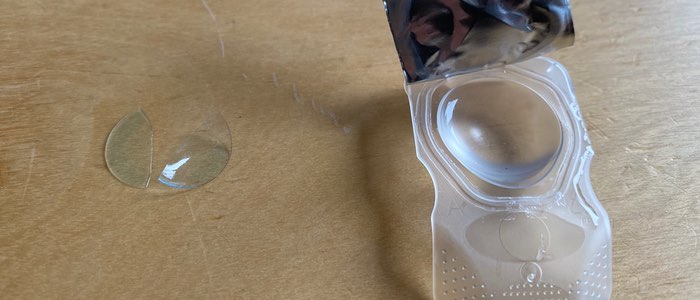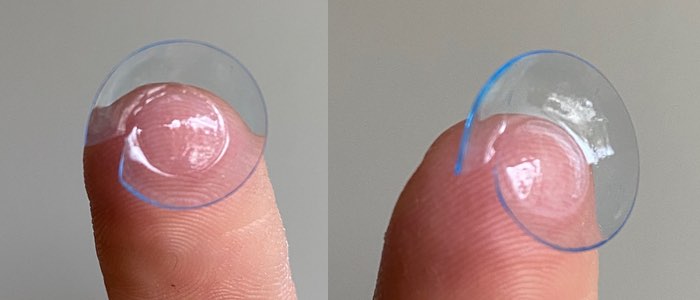Contact lenses tear because of less ideal conditions on the eye or when they get handled. Contact lenses typically tear easier when the water content evaporates over time and the lens material itself becomes less flexible. This oftentimes happens when the eyes feel dry. Another very important point when it comes to tearing a contact lens is how the wearers put them in and out. A lot of people wipe their eyes to get the contact lenses out or pinch them.
When the contact lens is pinched the lens material oftentimes already shows tiny rips under the microscope. When the wearer puts the lens on the eye it moves little thousands of times with every blink. This also puts strain on the contact lens material which could cause the tiny rip to split the contact lens in half.
Aside from the mechanical strain contact lenses need to endure during their life cycle chemical strain comes also into play. A lot of people use contact lens care products that are not compatible with their lenses. When the wrong cleaning agent is used to clean a contact lens the material usually gets more prone to tears and rips.
In this article, you will learn how easy it is to tear a soft contact lens and what you should avoid increasing the likelihood you do not end up with a torn contact lens.
Is It Easy To Tear a Contact Lens?
It is indeed very easy to tear a contact lens. Most contact lens wearers will have some experience with a torn contact lens in their hand or on the eye. Especially when someone is new to contact lenses and handles them in a rough way tears show up very fast. In addition to that, the person does not need to be extremely rough in handling the lenses. Just when the wearer needs relatively much time to get them on the eye the water content evaporates and the lens gets a lot more prone to tears.

In combination with a pinch, too much the contact lens is already cracked. In some cases, the blister of the contact lenses makes a tear more likely. The daily disposable contact lens Miru upside for example is a great lens but the blister has a bump on the bottom of the blister.
This in some cases causes the wearer of the contact lenses to pinch it a little too much and when the lens is pulled out of the blister a fine line can be seen in the middle of the lens. This is the beginning damage of the lens material which will lead the contact lens to a minimizing visual acuity and to be torn apart when used on the eye.
In the paragraphs above I mentioned a dried-out contact lens is more prone to be damaged when handling. After a long day, most wearers of contact lenses can ensure the lenses do not feel as wet as they did they first placed them on the eye in the morning. This is also why torn contacts are a very common thing. Nearly everyone has dryer eyes at times. And in those times it
What Does a Torn Contact Lens Look Like?
A torn contact lens can be still one piece but what you can see is a crack somewhere within the contact lens material. This contact lens even though it still looks like one piece is already torn and you should not put this broken lens on your eye. When the tear already got bigger the torn lens will be more obvious even to a novice wearer of contact lenses because he or she can see multiple parts which were one lens before.

As you can see in the picture below the a little crack in the middle of the lens. I always advise contact lens wearers even when they are an experiment to have a closer look at the contact lens on their finger before they put the lens on the eye. Just look at the lens and when it looks slightly ripped whether on the edges of the lens or the middle just replace this lens with a new one.
How To Avoid Torn Contact Lenses?
Ripping a contact lens should be an occasional occurrence. But when you have to deal with this issue more often you should consider the following advice to avoid torn contacts.
- Use a few drops of saline on the lens and eye before removing it
- Do not rub contact lenses excessively when cleaning
- Do not pinch contact lenses
- Try not to rub your eyes excessively while wearing your contacts
- Do not touch your contacts with your fingernails
When you use a few drops of saline or eye drops before removing the lens the contact lens material will hold more water content and is, therefore, more flexible and less prone, and durable. Speaking of the durability of contacts they are oftentimes as thin as 0.4 millimeters. When you rub your lenses which I recommend too as an optician do not rub them too hard and only for about 30 seconds or else risk damaging the lens.
Although contacts are very flexible they have their limits. pinching the contacts should be definitely avoided. Another no-not is to use your fingernails to grab the lenses. The low contact surface of the nails puts a mechanical strain on the lenses which makes them more likely to rip them apart.
When you followed the tips here in this article and occasionally you will still end up with two half of nine contact lenses in your eye you might switch to another brand. Some of the contact lenses are more or less easy to be torn apart. When you are not satisfied with your contacts talk to a local eye care specialist. He or she will have a closer look at your eyes and will recommend a lens that will work best for you.
Can You Fix a Ripped Contact Lens?
A ripped contact lens can not be fixed anymore. Do not put a ripped contact lens on your eye as it could harm your eye and will lead to excessive foreign body sensations.
I wish you a great day.
